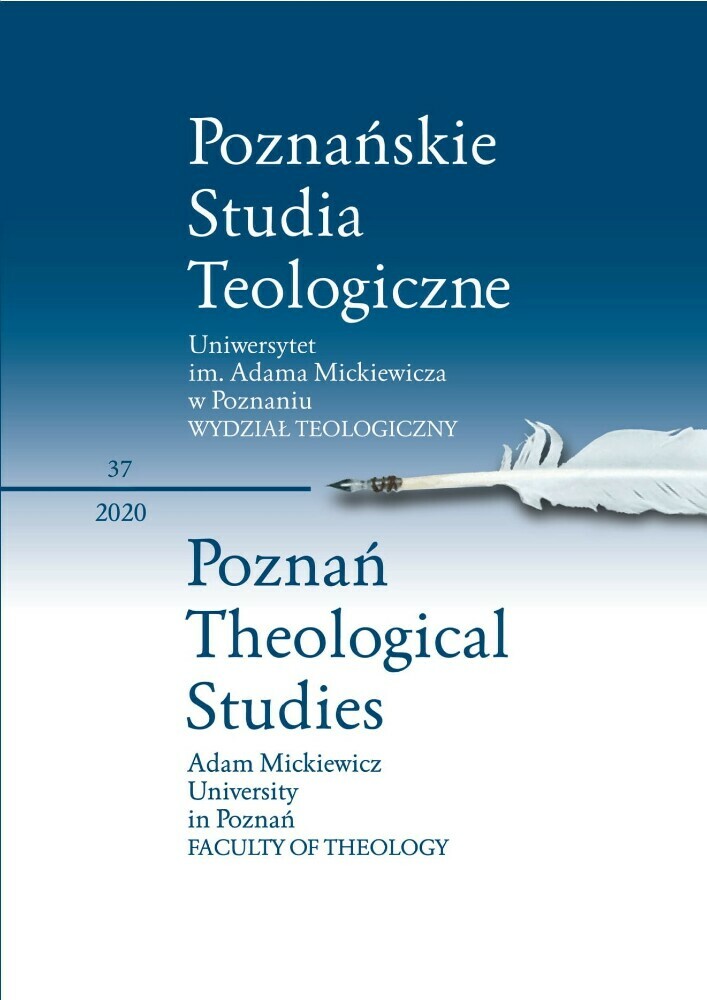Abstract
The Christological-pneumatological character of post-conciliar ecclesiology, which appreciates the personal-communal (relational), as well as historico-redemptive and eschatological character of the Church, and restores institutional-social dimension of the Church to its proper place in ecclesiology, opens the possibility of extending the traditional approach to the establishment of the Church as a historico-redemptive set of Christ’s actions. Deepened theological reflection on the pneumatological-personal (communio) character of the Church allows us to speak of its permanent personal-pneumahagic process of constant birth in the baptized ones and in the community of faith. Constant presence and influence of the Spirit in the community of the Church and its activities include its offices, evangelizing mission and means of sanctification, but also various gifts (charisms) of the Holy Spirit, as well as development or renewal of the faith life of individual Christians and the community. Aspects of permanent ecclesiogenesis can vary in intensity and form, but they all derive from the influence of the Spirit sent by Christ to His disciples, and are based on the personal, communal, event-oriented (historical) and processual character of faith as communio with Christ and brothers. The forms of permanent ecclesiogenesis can be seen in eschatological Church-directing tension dynamism between ‘already’ and ‘not yet’ of the Kingdom of God, in event-donative nature of faith as a communion with Jesus and its processual character, in life-giving character and fruitfulness of faith, in generating new ecclesial realities, clearly beyond human possibilities, in moving towards the missionary future, theological openness, and universality of the Church.
Literaturhinweise
Araszczuk S., Język i formy pobożności ludowej, “Seminare. Poszukiwania naukowe” 20 (2004), pp. 163–179.
Bartnik C.S., Dogmatyka katolicka, cz. 2, Lublin 2003.
Bartnik C.S., Osobowy byt Kościoła, in: Kościół w świetle Biblii, red. J. Szlaga, Lublin 1984, pp. 163–175.
Biela B., Struktura eklezjalnej wspólnoty we współczesnym nauczaniu Kościoła, “SSHT 2 (2011), pp. 529–546.
Coenen L., ἐκκλησία, in: Theologisches Begriffslexikon zum Neuen Testament, hrsg. v. L. Coenen, K. Haacker, Witten 20143, pp. 1136–1150.
Congar Y., Wierzę w Ducha Świętego. Duch Święty w „ekonomii”. Objawienie i doświadczenie Ducha, t. 1, tłum. A. Paygert, Warszawa 1995.
Congar Y., Wierzę w Ducha Świętego. „Panem jest Duch i daje życie” (2 Kor 3,17), t. 2, tłum. L. Rutkowska, Warszawa 1995.
Cordes P., „Ducha nie gaście”. Chryzmaty i nowa ewangelizacja, tłum. J. Sobociński, Gorzów Wielkopolski 1990.
Czaja A., Eklezjologia komunijna — próba określenia wartości i możliwości rozwoju, RT 55 (2008) 7, pp. 5–15.
Czaja A., Jedna osoba w wielu osobach. Pneumatologiczna eklezjologia Heriberta Mühlena, Opole 1997.
Czaja A., Podstawowe elementy eklezjologii «communio», “Teologia Praktyczna” 3 (2002), pp. 44–58.
Funk R.Y.K., Ciało Chrystusa, in: Słownik teologii św. Pawła, red. G.H. Hawthrone, R.P. Martin, D.G. Reid, tłum. zespół, Warszawa 2010, pp. 129–135.
Gręś S., Eschatyczny wymiar obecności Ducha Świętego w ziemskim życiu człowieka, in: Duch Odnowiciel, (Kolekcja Communio vol. 12), Poznań 1998, pp. 341–354.
Hryniewicz W., Zarys chrześcijańskiej teologii paschalnej, t. 2, Lublin 1987.
Jaśkiewicz S., Eklezjologia ludu Bożego w nurcie II Soboru Watykańskiego, in: Kościół lokalny w Kościele Chrystusa, red. R. Kantor, Kraków 2015, pp. 7–32.
Kasper W., Jezus Chrystus, tłum. B. Białecki, Warszawa 1983.
Kasper W., Kościół jako wspólnota. Refleksje nad eklezjologiczną ideą przewodnią Soboru Watykańskiego II, ComP 6 (1986) 4, pp. 28–42.
Kasprzak A.A., Pneumatologia w eklezjologii Konstytucji Lumen gentium Soboru Watykańskiego II z perspektywy teologii Yves’a Congara, “Poznańskie Studia Teologiczne” 33 (2018), pp. 41–65.
Kongregacja Nauki Wiary, List do biskupów Kościoła katolickiego o niektórych aspektach Kościoła pojętego jako komunia „Communionis notio” (1992).
Kongregacja Nauki Wiary, List Iuvenescit Ecclesia na temat relacji między darami hierarchicznymi a charyzmatycznymi dla życia i misji Kościoła (2016).
Kratz R.G., Kirche/Gemeinde (K./G.), in: Handbuch theologischer Grundbegriffe zum Alten und Neuen Testament (HGANT), hrsg. v. A. Berlejung, Ch. Frevel, 2015, pp. 286–289.
Kraus G., Die Kirche — Gemeinschaft des Heils: Ekklesiologie im Geist des Zweiten Vatikanischen Konzil, Regensburg 2012.
Królikowski J., Kościół w Jezusie Chrystusie: Chrystologiczno-pneumatologiczna geneza Kościoła, Kraków 2015.
McVay J.K., Głowa, Chrystus jako, in: Słownik teologii św. Pawła, Słownik teologii św. Pawła, red. G.H. Hawthrone, R.P. Martin, D.G. Reid, tłum. zespół, Warszawa 2010, pp. 268–269.
Mühlen H., Kirche wächst von innen: Weg zu einer glaubensgeschichtlich neuen Gestalt der Kirche. Neubestimmung des Verhältnisses von Kirche und Gesellschaft, Paderborn 1996.
Mühlen H., Una Mystica Persona. Die Kirche als das Mysterium der heilsgeschichtlichen Identität des Heiligen Geistes in Christus und den Christen: Eine Person In Vielen Personen, München–Paderborn 1968.
Nadbrzeżny A., Granice Kościoła jako problem hermeneutyczny, in: Koło Naukowe Teologów Katolickiego Uniwersytetu Lubelskiego Jana Pawła II, XLVI Tydzień Eklezjologiczny. Święty Kościół grzesznych ludzi (31 marzec – 3 kwiecień 2014 r.), Lublin 2014, pp. 64–78.
Neuner P., Zulehner P.M., Zrozumieć Kościół. Eklezjologia praktyczna, tłum. A. Kalbarczyk, Poznań 2016.
OʼBrien P.T., Kościół, in: Słownik teologii św. Pawła, red. G.H. Hawthrone, R.P. Martin, D.G. Reid, tłum. zespół, Warszawa 2010, pp. 402–410.
Pius XII, Mystici Corporis Christi, encyklika (1943).
Pozo G. del, Chrześcijańskie życie w Duchu i według Ojca, tłum. L. Balter, in: Duch Odnowiciel [Kolekcja Communio 12], Poznań 1998, pp. 218–232.
Ratzinger J., Ruchy kościelne i ich miejsce w teologii, tłum. Z. Kijas, “PostScriptum” 6 (1998), pp. 8–32.
Saarinen M.F., The Life Cycle of a congregation, Washington 1989.
Sikora R.A., Kościół jako Ciało Chrystusa w Kol i Ef, RT 44 (1997) 1, pp. 129–138.
Sobór Watykański II, Konstytucje. Dekrety. Deklaracje, Poznań 2002.
Suenens L.J., Kim jest Ona. Synteza mariologii, tłum. anon., Warszawa 1988.
Sullivan F.A., Duch Święty „zasadą jedności Kościoła”, ComP 8 (1988) 2, pp. 10–14.
Vass G., Die Kirche als Geistwerdung und Person werden der menschlichen Gesellschaft: Eine Auseinandersetzung mit Schleiermachers pneumatologischer Grundformel der Ekklesiologie, ZKTh 100 (1978) 1, pp. 140–177.
Wenk M., Duch Święty, tłum. R. Paprocki, in: Słownik nauczania Jezusa oraz tematów czterech Ewangelii. Komentarz tematyczny do Nowego Testamentu, t. 1, red. J.B. Green, J.K. Brown, N. Perrin, Warszawa 2017, pp. 145–151.
Wons K., Rozwój i zamieranie instytutów zakonnych, Kraków 2008 https://opoka.org.pl/biblioteka/T/TS/rozwoj_i_zamieranie_04.html.
Zulehner P.M., Grundkurs gemeindlichen Glaubens, Düsseldorf 1992.
Lizenz
© 2020 Uniwersytet im. Adama Mickiewicza w Poznaniu, Wydawnictwo Naukowe UAM, Poznań
OPEN ACCESS

